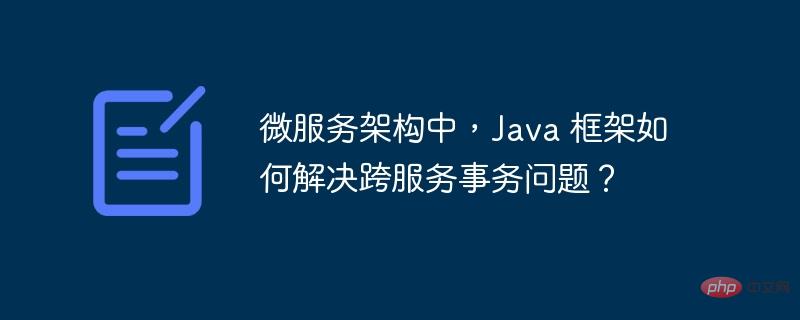Home >Java >javaTutorial >In microservice architecture, how does the Java framework solve cross-service transaction problems?
In microservice architecture, how does the Java framework solve cross-service transaction problems?
- 王林Original
- 2024-06-04 10:46:57561browse
The Java framework provides distributed transaction management functions to solve cross-service transaction problems in microservice architecture, including: Atomikos Transactions Platform: coordinates transactions from different data sources and supports the XA protocol. Spring Cloud Sleuth: Provides inter-service tracing capabilities and can be integrated with distributed transaction management frameworks for traceability. Saga Pattern: Decompose transactions into local transactions and ensure eventual consistency through the coordinator service.

How does the Java framework solve cross-service transaction problems in microservice architecture
In microservice architecture, cross-service transaction management is a common challenge. Different services may be managed by different databases or transaction managers, making it difficult to maintain atomicity, consistency, isolation, and durability (ACID) properties across services.
Java Framework Solution
To solve this problem, the Java ecosystem provides several frameworks that provide cross-service transaction management capabilities.
1. Atomikos Transactions Platform
Atomikos Transactions Platform is a Java framework that provides distributed transaction management capabilities, including coordinating transactions from different data sources. It supports the XA (Extensible Architecture) protocol, allowing applications to perform distributed transactions against multiple data sources.
// 创建一个 XA 数据源
AtomikosDataSourceBean ds = new AtomikosDataSourceBean();
ds.setXaDataSourceClassName("org.h2.jdbcx.JdbcDataSource");
// 注册 XA 数据源
DataSourceRegistry registry = new DataSourceRegistry();
registry.registerDataSource("my-ds", ds);
// 创建一个分布式事务管理器
TransactionManager tm = new DefaultTransactionManager(registry);
// 开始分布式事务
Transaction tx = tm.begin();
Connection conn = ds.getConnection();
// 执行事务性操作
// 提交 or 回滚分布式事务
tm.commit(tx);2. Spring Cloud Sleuth
Spring Cloud Sleuth is a Spring Boot framework that provides inter-service tracking functionality. It can be integrated with other distributed transaction management frameworks to achieve traceability of cross-service transactions.
// 在 Spring Boot 应用程序中添加 Sleuth
@SpringBootApplication
@EnableSleuth
@EnableDistributedTransaction
public class MyApplication {
// ...
}
// 添加 sleuth.sampler 属性以启用抽样
@Value("${sleuth.sampler.percentage:1.0}")
private float samplingPercentage;3. Saga Pattern
Saga pattern is a design pattern that decomposes distributed transactions into a series of local transactions and ensures the eventual consistency of transactions through the coordinator service.
// 创建一个协调器服务
@Service
public class SagaCoordinatorService {
// ...
}
// 创建本地事务服务
@Service
public class LocalTransactionService {
// ...
}Practical case
Use Atomikos Transactions Platform to manage cross-service transactions
In the procurement system, it needs to be executed between the order service and the inventory service Distributed transactions.
@Service
public class PurchaseService {
// ...
@Transactional
public void purchase(Order order) {
// 在订单服务中创建/更新订单
orderRepository.save(order);
// 在库存服务中扣减库存
// 获取库存服务 Connection 对象
Connection conn = ds.getConnection();
// ...
}
}Conclusion
By leveraging the distributed transaction management capabilities provided by the Java framework, cross-service transactions can be implemented in a microservice architecture. These frameworks provide a range of methods to coordinate transactions on disparate data sources, ensuring ACID properties and traceability of operations across services.
The above is the detailed content of In microservice architecture, how does the Java framework solve cross-service transaction problems?. For more information, please follow other related articles on the PHP Chinese website!

